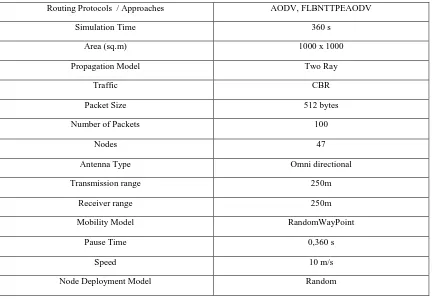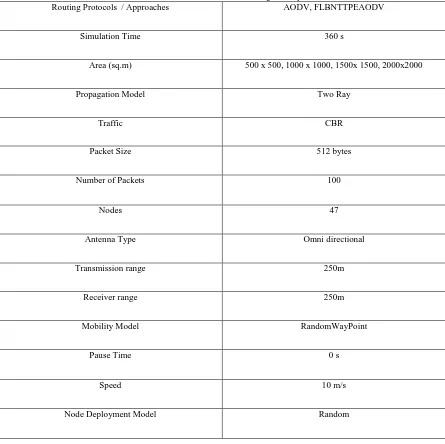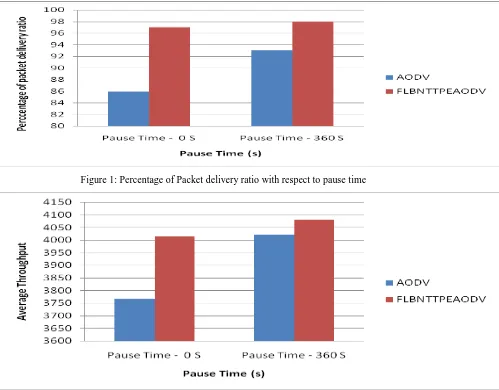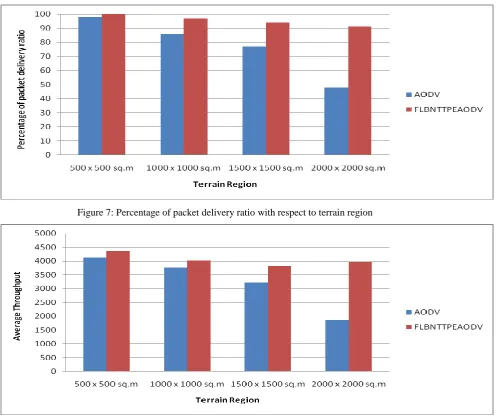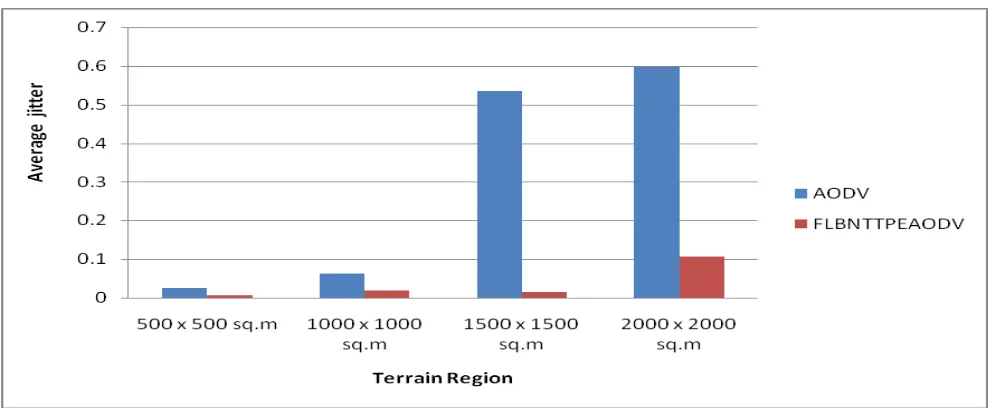Available Online atwww.ijcsmc.com
International Journal of Computer Science and Mobile Computing
A Monthly Journal of Computer Science and Information Technology
ISSN 2320–088X
IJCSMC, Vol. 4, Issue. 9, September 2015, pg.276 – 283
RESEARCH ARTICLE
Investigating the Impact of Pause Time and
Terrain Regions on the Performance of AODV
and FLBNTTPEAODV for MANETs
K.Narasimha Raju
1, Dr. S.Pallam Setty
2¹Research Scholar, CS & SE Department, Andhra University ²Professor, CS & SE Department, Andhra University
1
bcoolmind@gmail.com, 2 drspsetty@gmail.com
Abstract— The mobility nature of the nodes in the Mobile ad hoc network leads to dynamic topology. Establishing proper paths among the nodes for communication in this kind of network is really a challenging aspect. In this paper, the impact of pause time and terrain regions on AODV and FLBNTTPEAODV routing approaches are investigated using network simulator version 2.34. Significant performance improvement is observed in packet delivery ratio and a huge reduction in end-to-end delay with FLBNTTPEAODV.
Keywords— AODV, FLBNTTPEAODV, MANETs, Performance, Routing Protocols
I. INTRODUCTION
Mobile Ad-hoc network [1][2][3] is an infrastructure-less network consisting of mobile nodes connected by wireless links. The mobile nodes establishes the dynamic topology due to their mobility feature. The mobility models [4] describes the movement behaviour of the mobile nodes in the network. Thus the routing in the mobile ad hoc network became a challenging issue[5]. Various routing protocols [6][7][8] are proposed and developed to find a better route for communication among the nodes. The following sections i.e., sections 2 describes AODV on-demand routing protocol, section 3 illustrates the importance of FLBNTTPEAODV, Section 4 deals with the Simulation parameters used in the experiment, presentation of the results are done in section 5 and conclusion is described in section 6.
II. AD-HOCONDEMANDDISTANCEVECTORROUTINGPROTOCOL(AODV)
III.FUZZYLOGICBASEDNODETRAVERSALTIMEPERFORMANCEENHANCEDAODV (FLBNTTPEAODV)
The AODV routing protocol maintains constant values for some of the parameters during its configuration. One of the parameter in this category is Node Traversal Time. The Fuzzy Logic Based Node Traversal Time Performance Enhanced AODV (FLBNTTPEAODV) [11] indicates that the Node Traversal Time must be a suitable value with respect to the Network size. Previously, the FLBNTTPEAODV is evaluated in small, medium, large and very large network sizes. It was found that, it is highly suitable for medium size networks. The present work deals with the impact of pause time and terrain regions on both AODV and FLBNTTPEAODV in medium network size.
IV.SIMULATIONENVIRONMENT
Network simulator version 2.34 [12] is used to evaluate the FLBNTTPEAODV and AODV. The simulation parameters used in the pause time experiment 1 and terrain region experiment2 evaluate performance [13][14][15][16] are elaborated in the tables 1 and 2 respectively.
A. Experiment 1
The performance of the two routing approaches AODV and FLBNTTPEAODV are evaluated in various pause timings with the simulation parameters prescribed in table 1.
Table 1 : Simulation Parameters used in the Pause Time Experimental Evaluation
Routing Protocols / Approaches AODV, FLBNTTPEAODV
Simulation Time 360 s
Area (sq.m) 1000 x 1000
Propagation Model Two Ray
Traffic CBR
Packet Size 512 bytes
Number of Packets 100
Nodes 47
Antenna Type Omni directional
Transmission range 250m
Receiver range 250m
Mobility Model RandomWayPoint
Pause Time 0,360 s
Speed 10 m/s
Node Deployment Model Random
B. Experiment 2
Table 2 : Simulation Parameters used in the Terrain Regional Experimental Evaluation
Routing Protocols / Approaches AODV, FLBNTTPEAODV
Simulation Time 360 s
Area (sq.m) 500 x 500, 1000 x 1000, 1500x 1500, 2000x2000
Propagation Model Two Ray
Traffic CBR
Packet Size 512 bytes
Number of Packets 100
Nodes 47
Antenna Type Omni directional
Transmission range 250m
Receiver range 250m
Mobility Model RandomWayPoint
Pause Time 0 s
Speed 10 m/s
Node Deployment Model Random
V. RESULTS
Figure 1: Percentage of Packet delivery ratio with respect to pause time
Figure 2: Average Throughput with respect to pause time
Figure 4: Average jitter with respect to pause time
Figure 7: Percentage of packet delivery ratio with respect to terrain region
Figure 10: Average jitter with respect to terrain region
Figure 11: Routing Overhead with respect to terrain region
VI.CONCLUSIONS
From the simulation results, it was observed that FLBNTTPEAODV performs better than AODV in the above QOS metrics. It is also observed that it shows better performance in the above terrain regions. Significant improvements are the percentage of packet delivery ratio was enhanced by 12.79 % and 5.37 % at low and high pause timings. Another improvement is 64.96% of average end-to-end delay was reduced by FLBNTTPEAODV than AODV in the case of 1000 x 1000 terrain region.
REFERENCES
[1] Iiyas, M., 2003. The Hand Book Of Ad Hoc Networks, CRC Press. [2] Perkins C., Ad Hoc Networking, Addison Wesley, 2001
[3] D. P. Agrawal and Q-A Zeng. “Introduction to Wireless and Mobile Systems,” Brooks/Cole Publishing, ISBN No. 0534-40851-6, 436 pages, 2003.
[4] T. Camp, J. Boleng, and V. Davies, A Survey of Mobility Models for Ad Hoc Network Research, in Wireless Communication and Mobile Computing (WCMC): Special issue on Mobile Ad Hoc Networking: Research, Trends and Applications, vol. 2, no. 5, pp. 483-502, 2002
[5] S. Giordano and W. W. Lu, “Challenges in mobile ad hoc networking,” IEEE Communications Magazine, vol. 39, no. 6, pp. 129–181, June 2001.
[6] Hongbo Zhou, “A Survery on Routing Protocols in MANETs,” Technical. Note March 2003.
[7] David B. Johnson ,”Routing in Ad Hoc Networks of Mobile Hosts,” in Proceeding of the IEEE workshop on Mobile Computing Systems and Application , Dec 1994.
[8] E. M. Royer, and C.-K. Toh, “A review of current routing protocols for ad hoc mobile wireless networks”, IEEE Personal Communications, Apr. 1999, pp. 46–55
[9] C.E. Perkins, E.M. Royer & S. Das, Ad Hoc On Demand Distance Vector (AODV) Routing, IETFInternet draft, draft-ietf-manet-aodv- 08.txt, March 2001
[10] Perkins C. and Royer E.M., “Ad-Hoc on-Demand Distance Vector Routing,” in Proceedings of the 2nd IEEE Workshop on Mobile Computing Systems and Applications, New Orleans, LA, pp. 90-100, February 1999.
[11] K. Narasimha Raju and Dr. S.P.Setty, “Design and Implementation of Fuzzy Logic Approach for fine tuning of configuration parameters in AODV to enhance the performance in MANETs”, International Journal of Computer Networks and Wireless Communications (IJCNWC),Vol.5- No.4,August, 2015.
[12] Network simulator -2. http://www.isi.edu/nsnam/ns/
[13] A. Nasipuri, R. Castaneda, and S. R. Das, “Performance of multipath routing for on-demand protocols in ad hoc networks,” Mobile Networks Applicat. (MONET) J., vol. 6, no. 4, pp. 339–349, 2001.
[14] C.-E. Perkins, E.-M. Royer, S.-R. Das, and M.-K. Marina, “Performance comparison of two on-demand routing protocols for ad hoc networks,” IEEE Personal Communications, vol. 8, no. 1, pp. 16–28, Feb 2001.
[15] J. Broch, D. Maltz, D. Johnson, Y.-C. Hu, and J. Jetcheva, “A Performance Comparison of Multihop Wireless Ad Hoc Network Routing Protocols”, ACM/IEEE Mobile Computing and Networking, October 1998.
